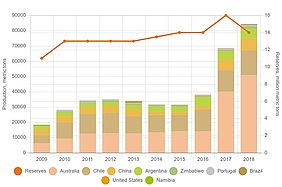Lithium is considered to be a strategically important metal due to a number of its unique properties. In terms of power engineering, the most important quality is that lithium successfully combines value of standard electrode potential and density, which makes it indispensable for the production of storage batteries. U.S. The Geological Survey publishes Lithium Statistics and Information1 on a yearly basis. The last issue was published in January 2020, and in June BP published a new issue of the Statistical Review of World Energy2, which also contains information on the production of lithium in the world.
According to the USGS, in 2019 global production of lithium, excluding the United States, decreased by 19% to 77,000 tons, compared to 95,000 in 2018. Australia was the leader in production, as in the previous year, but there was also the strongest decline in the year from 58,800 tons to 42,000 tons. The decline in lithium production in Canada was even more tangible - from 2,400 to 200 tons. Portugal, Chile and China increased production significantly. The BP report cites slightly lower values for Australia and Chile, while US production is estimated at 900 tonnes.
The main consumer of lithium is the battery industry, which accounted for 65% of its share last year. Interestingly, relatively recently in 2014, USGS reported a 31% share of lithium consumption for batteries with a production volume of 36,000 tons. Thus, in a relatively short time, large-scale changes have taken place, both in the structure of production and consumption of lithium.
World lithium reserves in 2019 were estimated by the USGS at 17 million tons, 20% more than a year earlier and 30% more than 10 years ago. More than half of the reserves are concentrated in Chile.
According to the USGS, the world's lithium resources amounted to 80 million tons, Bolivia has the largest reserves of this volume – 21 million tons, Argentina – 17 million tons, Chile – 9 million tons, Australia – 6.3 million tons and China – 4.5 million tons In 2010, the total amount of resources was calculated at the level of 33 million tons, and thus it increased during this time by almost 2.5 times.
The USGS also reports in its publication that the prices of lithium products have dropped significantly over the past year. Thus, the prices for lithium carbonate in China fell by more than 35%, and in the USA by 24%. The prices for lithium hydroxide fell even more dramatically (almost 50%, China). The price of lithium metal has dropped by about 30%. Such serious changes in the market have led to the suspension of some mining enterprises in Australia, Canada and Namibia, and also led to the adjustment of plans to expand production in other countries.
Apparently, the negative events associated with the coronavirus pandemic in 2020 cannot contribute to the boosting of lithium production; however, the need to maintain the security of supplies from various sources, including brine-based lithium, and mineral based lithium, and lithium-clay, could possibly enable this industry to survive tough times with smaller losses.
1Lithium Statistics and Information/ https://www.usgs.gov/centers/nmic/lithium-statistics-and-information
2Statistical Review of World Energy 2020 | 69th edition/ https://www.bp.com/content/dam/bp/business-sites/en/global/corporate/pdfs/energy-economics/statistical-review/bp-stats-review-2020-full-report.pdf
